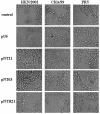RNA interference targeting VP1 inhibits foot-and-mouth disease virus replication in BHK-21 cells and suckling mice
- PMID: 15194766
- PMCID: PMC421660
- DOI: 10.1128/JVI.78.13.6900-6907.2004
RNA interference targeting VP1 inhibits foot-and-mouth disease virus replication in BHK-21 cells and suckling mice
Abstract
RNA interference (RNAi) is a powerful tool to silence gene expression posttranscriptionally. In this study, we evaluated the antiviral potential of small interfering RNA (siRNA) targeting VP1 of foot-and-mouth disease virus (FMDV), which is essential during the life cycle of the virus and plays a key role in virus attachment to susceptible cells. We investigated in vivo the inhibitory effect of VP1-specific siRNAs on FMDV replication in BHK-21 cells and suckling mice, a commonly used small animal model. The results showed that transfection of siRNA-expressing plasmids gave an 80 to 90% reduction in the expression of FMDV VP1 in BHK-21 cells. Moreover, BHK-21 cells transiently transfected with siRNA-expressing plasmids were specifically resistant to FMDV infection when exposed to 100 50% tissue culture infective doses of virus, and the antiviral effects extended to almost 48 h postinfection. Furthermore, subcutaneous injection of siRNA-expressing plasmids in the neck made suckling mice significantly less susceptible to FMDV. In conclusion, our data suggests that RNAi may provide a viable therapeutic approach to treat FMDV infection.
Figures






References
-
- Alcala, P., J. X. Feliu, A. Aris, and A. Villaverde. 2001. Efficient accommodation of recombinant foot-and-mouth disease virus RGD peptides to cell-surface integrins. Biochem. Biophys. Res. Commun. 285:201-206. - PubMed
-
- Bachrach, H. L., D. M. Moore, P. D. McKercher, and J. Polatnick. 1975. Immune and antibody responses to an isolated capsid protein of foot-and-mouth disease virus. J. Immunol. 115:1635-1641. - PubMed
-
- Barnett, P. V., and H. Carabin. 2002. A review of emergency foot-and-mouth disease (FMD) vaccines. Vaccine 20:1505-1514. - PubMed
-
- Baxt, B., and Y. Becker. 1990. The effect of peptides containing the arginine-glycine-aspartic acid sequence on the adsorption of foot-and-mouth disease virus to tissue culture cells. Virus Genes 4:73-83. - PubMed
Publication types
MeSH terms
Substances
LinkOut - more resources
Full Text Sources
Other Literature Sources

